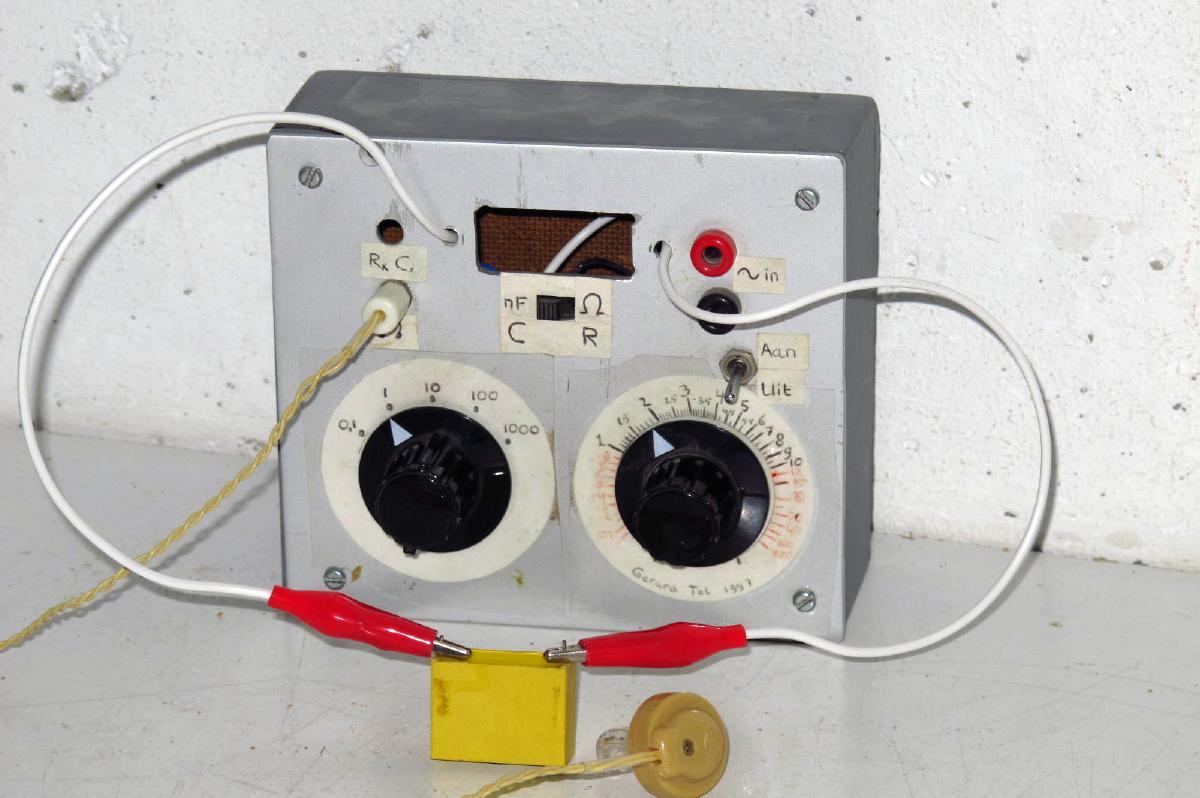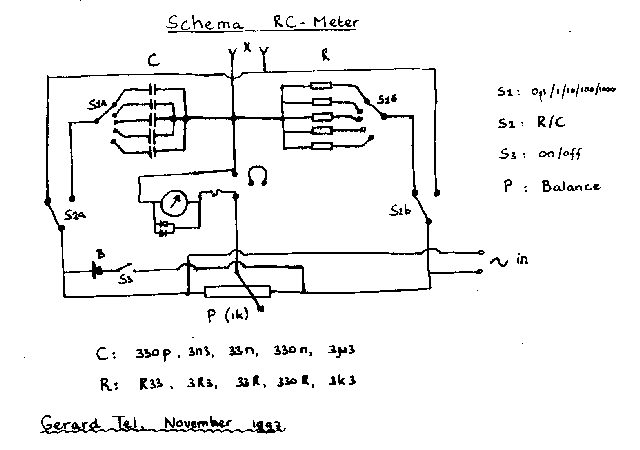
80
Item nr.

Gerard Singing RC Meter
A project I built twice.
Data for Gerard Singing RC Meter
| Production | The Netherlands, 1997.
|
|---|
| Bands | Ten measuring ranges, running from 1 to 10 times either 0.1, 1, 10, 100 or 1000, Ohms or nanoFarads. |
|---|
Semi-
conductors | Chip. |
|---|
| Cabinet | Wood.
Size 13.5x12x5 cm.
|
|---|
| Power | Batt 2x button cell LR1130. |
|---|
| Documents | Schema. |
|---|
The Design
This small meter was constructed by myself in 1997, and later rehauled in 2013. Resistance measurements are carried out with two resistance voltage dividers, forming a bridge. One is formed by the unknown resistance and a known one, the other by the two parts of an (adjustable) potentiometer. The aim of the game is to set the adjustable divider in such the position where the bridge is balanced, that is, there is no voltage between the midpoints of the two voltage dividers. The bridge was originally fed from a 9V battery and the voltage between the midpoints is indicated by the panel meter. Later I built in a song generator and speaker/earpiece. One can switch between five ranges by choosing among five known resistances.
Capacitors are not measured with DC, but with alternating current from the song generator. An earphone is used to find the bridge equilibrium. The unknown cap forms a voltage divider together with one of a set of five known capacitors.

 A bad (leaky) capacitor has a phase diagram that differs from the phase diagram of the (good) capacitors built into the bridge. As a result, the signal at the midpoint of the voltage divider formed by the capacitors is shifted in phase wrt. the signal fed into the bridge, and it becomes impossible to completely silence the whistle in the headphone. Consequently, leakage of the capacitor is qualitatively indicated by an audible level of residu sound at the best position of the potentiometer. Unlike other meters of this type, my meter reads resistance and capacitance from the same scale. To this end, the R/C switch not only replaces the reference resistors by reference capacitors, but also swaps the fixed and potentiometer sides of the bridge. On the right three capacitors.
A bad (leaky) capacitor has a phase diagram that differs from the phase diagram of the (good) capacitors built into the bridge. As a result, the signal at the midpoint of the voltage divider formed by the capacitors is shifted in phase wrt. the signal fed into the bridge, and it becomes impossible to completely silence the whistle in the headphone. Consequently, leakage of the capacitor is qualitatively indicated by an audible level of residu sound at the best position of the potentiometer. Unlike other meters of this type, my meter reads resistance and capacitance from the same scale. To this end, the R/C switch not only replaces the reference resistors by reference capacitors, but also swaps the fixed and potentiometer sides of the bridge. On the right three capacitors.
Current draw from the LR1130 cells is about 2mA during a measurement with a crystal earpiece, 10mA during measurement with the speaker, and 50uA when the song finishes. This current would drain the cells in about a kiloHour, so don't forget to switch off!
| Obtained | 11/1997
from old parts mostly. |
|---|
| Condition | 6. |
|---|
| Value (est.) | 3,3€. |
|---|
| Sound sample | PLAY SOUND The built in song Ik lag gebroken in mijn bed is just long enough to search for minimum sound. |
|---|
This Object
In 1997 I made this little box, and it contained little more than the Wheatstone bridge with connectors. To measure capacitors, you had to connect the unknown cap, the tone generator and an earpiece. Later I decided that this should work easier. 
 Around my birthday I got one of these cards that play a song when you open them. This is typical throw-away electronics, but don't! After listening it a few times, I cut open the card and found a song generator print with battery cells, and an 8 Ohm microspeaker. I connected the generator as the bridge feed, and the speakers as the bridge zero detector. It is now possible to do (some) measurements by connecting only the unknown R or C, everything else is built in.
Around my birthday I got one of these cards that play a song when you open them. This is typical throw-away electronics, but don't! After listening it a few times, I cut open the card and found a song generator print with battery cells, and an 8 Ohm microspeaker. I connected the generator as the bridge feed, and the speakers as the bridge zero detector. It is now possible to do (some) measurements by connecting only the unknown R or C, everything else is built in.

 Because the speaker is only 8 Ohms, it plays very softly when larger resistors (or smaller caps) are measured, so in practice it will not allways be possible to measure by speaker. Most measurements require to connect a crystal earpiece, and then a 2 - 5% accuracy is achieved in the specified range (black on the dial).
Because the speaker is only 8 Ohms, it plays very softly when larger resistors (or smaller caps) are measured, so in practice it will not allways be possible to measure by speaker. Most measurements require to connect a crystal earpiece, and then a 2 - 5% accuracy is achieved in the specified range (black on the dial).
The original unit had a panel meter (right) but that was removed. The schema shown above is the original one, with only a battery but no song generator and no speaker.
Part of Gerard's Radio Corner.
Generated by SiteBuilder on
4/6/2024
by Gerard
(gerardtel@gmail.com)

 A bad (leaky) capacitor has a phase diagram that differs from the phase diagram of the (good) capacitors built into the bridge. As a result, the signal at the midpoint of the voltage divider formed by the capacitors is shifted in phase wrt. the signal fed into the bridge, and it becomes impossible to completely silence the whistle in the headphone. Consequently, leakage of the capacitor is qualitatively indicated by an audible level of residu sound at the best position of the potentiometer. Unlike other meters of this type, my meter reads resistance and capacitance from the same scale. To this end, the R/C switch not only replaces the reference resistors by reference capacitors, but also swaps the fixed and potentiometer sides of the bridge. On the right three capacitors.
A bad (leaky) capacitor has a phase diagram that differs from the phase diagram of the (good) capacitors built into the bridge. As a result, the signal at the midpoint of the voltage divider formed by the capacitors is shifted in phase wrt. the signal fed into the bridge, and it becomes impossible to completely silence the whistle in the headphone. Consequently, leakage of the capacitor is qualitatively indicated by an audible level of residu sound at the best position of the potentiometer. Unlike other meters of this type, my meter reads resistance and capacitance from the same scale. To this end, the R/C switch not only replaces the reference resistors by reference capacitors, but also swaps the fixed and potentiometer sides of the bridge. On the right three capacitors. 


 Around my birthday I got one of these cards that play a song when you open them. This is typical throw-away electronics, but don't! After listening it a few times, I cut open the card and found a song generator print with battery cells, and an 8 Ohm microspeaker. I connected the generator as the bridge feed, and the speakers as the bridge zero detector. It is now possible to do (some) measurements by connecting only the unknown R or C, everything else is built in.
Around my birthday I got one of these cards that play a song when you open them. This is typical throw-away electronics, but don't! After listening it a few times, I cut open the card and found a song generator print with battery cells, and an 8 Ohm microspeaker. I connected the generator as the bridge feed, and the speakers as the bridge zero detector. It is now possible to do (some) measurements by connecting only the unknown R or C, everything else is built in. 
 Because the speaker is only 8 Ohms, it plays very softly when larger resistors (or smaller caps) are measured, so in practice it will not allways be possible to measure by speaker. Most measurements require to connect a crystal earpiece, and then a 2 - 5% accuracy is achieved in the specified range (black on the dial).
Because the speaker is only 8 Ohms, it plays very softly when larger resistors (or smaller caps) are measured, so in practice it will not allways be possible to measure by speaker. Most measurements require to connect a crystal earpiece, and then a 2 - 5% accuracy is achieved in the specified range (black on the dial).